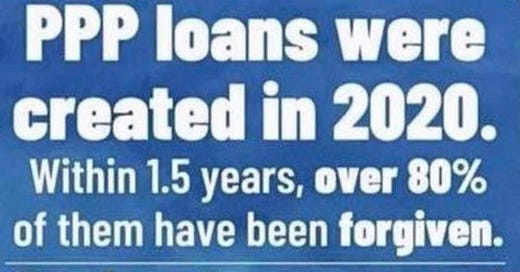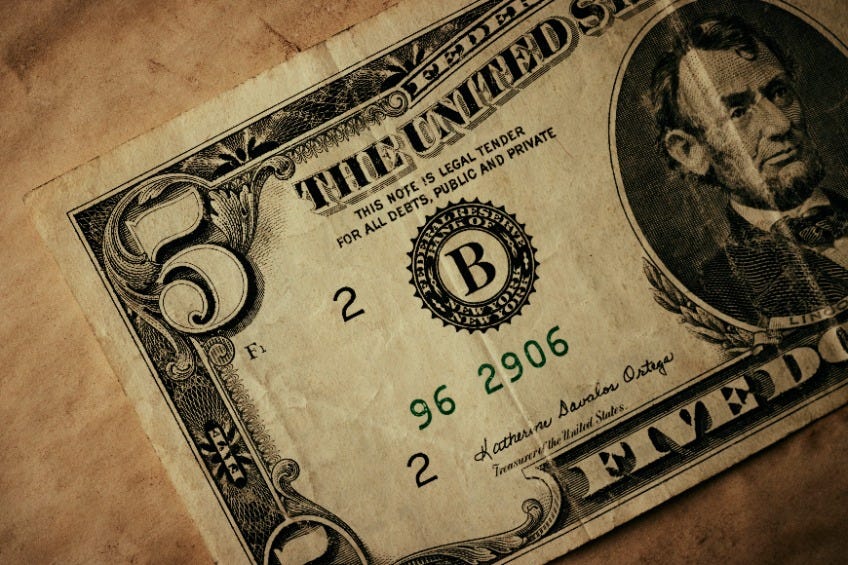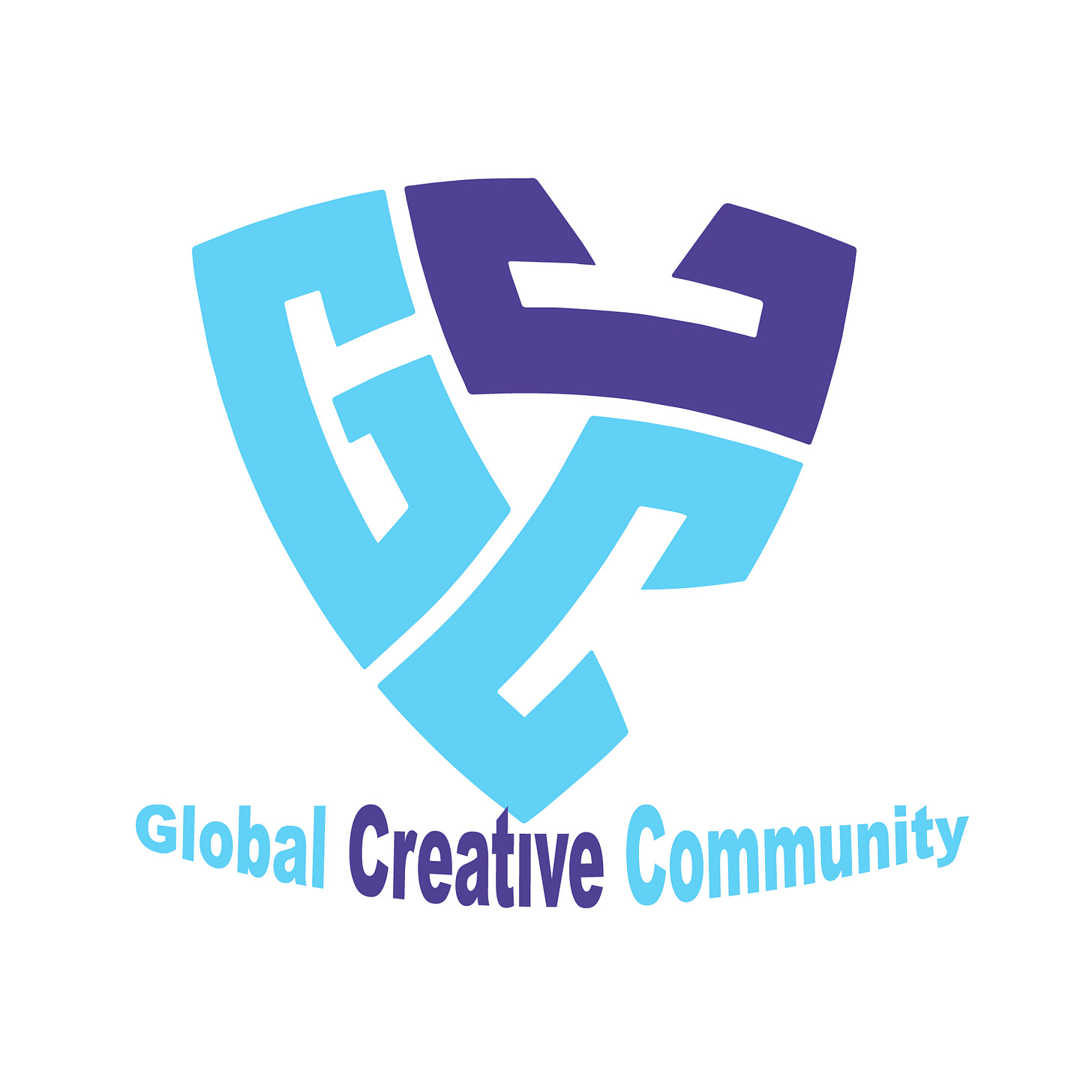Student Loan Forgiveness vs PPP Loan Forgiveness
One costs the taxpayers $0 but is vilified, while the other costs taxpayers $500B+ and is lauded.
Issue #593 The Choice, Monday, May 6, 2024
A full podcast of the audio for the eight weekly W.A.S. posts from the previous week will be published every Tuesday on Apple Podcasts and Spotify Podcasts.
Please also scroll to the end of this post for other ways to financially support We Are Speaking.
We appreciate your support!
There is a lot of discussion these days about the Biden administration fulfilling its campaign promise to forgive many of the loans taken out by people for advanced education who have been unfairly burdened by exorbitant interest fees and fraudulent practices.
Many people are complaining that forgiving student loans now is not fair to those who paid back their own student loans, so why should they “pay for rich people’s loans?”
However, that’s not how student loan forgiveness works. No taxpayer money is used for student loan forgiveness, and the lending institutions long ago received back the principal and millions in interest and fees.
The Paycheck Protection Program of 2020-2021 did use federal taxpayer funds, and most of the loans were forgiven.
More on the difference in a minute, but first, a little history.
Before World War II, only about 14% of Americans completed high school, and less than 5% of Americans completed four years of college.
After WWII, the government decided that having an educated populous would be an investment in America and in the U.S. economy, and Congress not only passed the GI Bill that helped veterans pay for college and trade school but also allowed the federal government to help subsidize higher education for everyone with low-interest loans that could be paid back relatively easily.
In 1965, the Higher Education Act was passed to help make college more affordable through financial aid from the government to students.
In the 1960s, the average cost of tuition and fees at any 4-year college increased at an annual rate of 6.1%.
The average cost of attendance at any postsecondary institution grew at an annual rate of 4.2%.
Between 2009-10 and 2019-20, the total cost of attendance (fees, tuition, room, and board) saw an increase of 39.9% at public 4-year schools.
Between 1999-2000 and 2019-20, tuition at the average 4-year institution increased 136.5%.
Tuition and fees in the 1990s increased 25% faster than growth rates in the 21st century at a rate of 8.5%.
The rising costs of college tuition outpace the rate of inflation 171.5%.
The average cost of tuition & fees at private 4-year institutions has risen 124.2% over the last 20 years.
Since 1990, average tuition and fee rates have increased 130% after adjusting for inflation.
I grew up in the 1950s and 1960s when most families could live comfortably on one adult’s salary. Both of my parents worked, and they decided to “bank” my mother’s salary. Those savings paid for the undergraduate expenses of their four daughters.
The cost for our graduate degrees, however, was on us. I remember taking out a federally subsidized loan for my Master’s degree in the early 1970s, and I also remember that the monthly payments were manageable.
Additionally, because I went into education, after five consecutive years of teaching, the remainder of my loan was forgiven, and I went on to teach for about 40 years without the burden of paying off a student loan that had ever-increasing and budget-crushing interest rates.
By 1981, when Ronald Reagan became president, and the Republicans in charge decided that any government assistance for middle- and lower-income people was “socialism,” the majority of the student loan process was turned over to private companies and for-profit schools. The cost of a degree from public colleges and universities sky-rocketed, interest rates ballooned, and many for-profit schools fraudulently charged their students inflated fees but didn’t work to help the students actually graduate or get good-paying jobs.
Now many people have been making payments on their loans for decades, often at several hundred dollars per month, even if they didn’t graduate and/or get a job with a relatively medium or high salary. Most of those people long ago paid off the principal of their loans and are now just paying the interest.
The initial stages of the Biden administration’s student loan forgiveness were limited to people who received Pell loans of $10,000 and up to $20,000 of other loans, and 90% of the people who initially received forgiveness had annual incomes of less than $75,000, which is hardly considered being “rich.”
The Republicans in the House and Senate tried to cancel any student loan forgiveness, but President Biden found workarounds to help people who had been paying the premiums for a minimum of ten years and never missed a payment.
Now, the program has been expanded to include people in certain industries such as nursing and teaching, etc., as well as the loans for people who were caught up in fraudulent for-profit trade school scams, like Trump University.
The loan forgiveness program has been life-changing for tens of thousands of Americans, freeing up funds that can now be used to buy homes and improve the economy in tangible ways because those people now have much more disposable income.
Some people who took out a $70,000 loan thirty years ago and paid the premiums every month, still owed $160,000 on those loans.
Most importantly, the student forgiveness programs do not cost the American taxpayer a dime, because the premiums that included exorbitant interest and other fees were being paid to financial institutions.
Once again, the student loan forgiveness programs are an investment in the education of Americans and a boost to the U.S. economy.
On the other hand, the Paycheck Protection Program (PPP) was a $953-billion business loan program established by the United States federal government during the Trump administration in 2020 through the Coronavirus Aid, Relief, and Economic Security Act (CARES Act) to help certain businesses, self-employed workers, sole proprietors, certain nonprofit organizations, and tribal businesses continue paying their workers. The Paycheck Protection Program allowed entities to apply for low-interest private loans to pay for payroll and certain other costs.
Some economists have found that the PPP did not save as many jobs as purported and aided too many businesses that were not at risk of going under. The program was criticized for its exorbitant cost, costing approximately $169k - $258k per job saved, and the actual workers received no direct benefit from those loans.
The CARES Act was supposedly intended to help businesses stay afloat during the COVID-19 pandemic, but the results for recipients were varied. In July 2020, a National Geographic article, citing the Center for Responsible Lending, reported that 95% of Black-owned businesses and 91% of Latino-owned businesses were unlikely to receive loans because they were very small businesses with few employees and because they did not have existing relationships with banks. The article also said that because of COVID, 41% of Black-owned businesses had already closed permanently while only 17 percent of white-owned businesses met this fate.
Billions of dollars went to companies owned by wealthy celebrities, including Tom Brady and Khloe Kardashian, and companies that thrived during COVID, like many manufacturing and construction firms.
Some PPP loans were received by businesses owned or run by members of Congress or their spouses, including Majorie Taylor Greene, and Trump-related people and businesses, including Jared Kushner, Ivanka Trump, and White House Press Secretary Kayleigh McEnany received millions of dollars in PPP loans that were forgiven using taxpayer money.
Businesses with addresses at properties owned by President Trump and advisor Jared Kushner received at least 25 PPP loans totaling over $3.65 million. Triomphe Restaurant Corp., at the Trump International Hotel and Tower in New York City, received a PPP loan of $2,164,543, and it reported having zero employees.
The Act stated that entities that received a PPP loan of less than $150,000, rather than the initial $50,000, would be eligible to use a simplified one-page loan forgiveness application.
NPR found that the smallest businesses — sole proprietors like barbers, janitors, and hairdressers — hold the highest rate of unforgiven loans, at 13%. By contrast, only 3% of all businesses with at least 10 employees have unforgiven loans.
More than 4.5 million businesses had received over $500 billion of taxpayer money.
The Small Business Administration found that 92% of the loans issued have been granted full or partial forgiveness. That includes millions of dollars of loans to companies with mega-rich owners, all borne by the American taxpayer.
Meanwhile, the government is forgiving federal student loans through programs like income-driven repayment (IDR) and Public Service Loan Forgiveness (PSLF). Borrowers who’ve been defrauded by their schools are also be eligible for loan forgiveness.
Income-driven repayment forgiveness:
Total debt forgiven: $45.7 billion.
Average amount of forgiveness per borrower: $49,113.
Public Service Loan Forgiveness:
Total debt forgiven: $56.7 billion.
Average amount of forgiveness per borrower: $71,465.
So we can ask ourselves: why is the Student Loan Forgiveness Program (~$102.4B) not costing the taxpayers receiving so much flack, while those who received millions in PPP loan forgiveness (>$500B), with the massive fraud incurred by the PPP that is being paid by taxpayers proceeded under the radar of criticism?
The answer seems to be the same: for Republicans and the right wing, anything that helps low- and middle-income people, particularly people of color is “socialism” and immediately suspect. Anything that helps wealthy and primarily white people, even though it burdens the average American taxpayer, is A-OK and should never be questioned.
Help us to grow “We Are Speaking”!
The “Comments” feature is available for paid subscribers. You can also discuss these facts in our community on Substack Notes. You can also read other Substack publications without subscribing to them when you join Notes.
This post is free to read for three days. To have 365/24/7 access to all our posts and financially support “We Are Speaking” for no more than $5 per month, please subscribe at the paid level. You will receive a 7-day FREE trial!
Independent Authors and Creative Professionals: Branding and Marketing Courses and Networking Groups are available in the GCC Branding and Marketing Academy!
Pam’s Business Books and Keith’s SciFi Books are available for purchase here!






